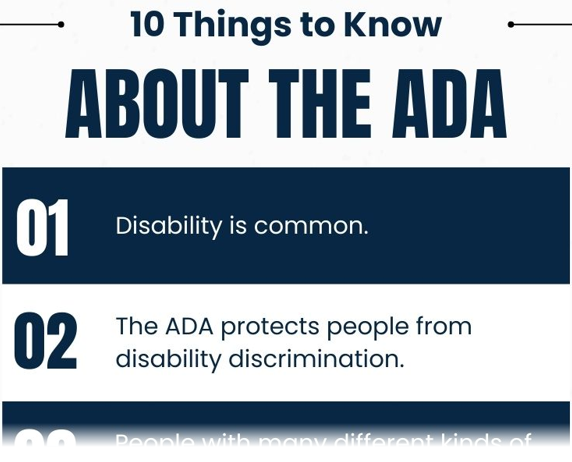(Printer-Friendly PDF version | 155 KB)
(Versión en español)
The Americans with Disabilities Act (ADA) became a law in 1990. It had strong bipartisan support and was signed by President George H.W. Bush. Although it has been around for decades, you may not know how the ADA helps to ensure that people with disabilities have an equal opportunity to participate in their communities. This fact sheet gives basic overviews of 10 things you should know about the ADA.
-
Disability is common.
More than one out of every four people has a disability.1 People of all ages have disabilities, including children and older people. Some people are born with a disability, and others develop a disability. Anyone can become disabled. -
The ADA protects people from disability discrimination.
The purpose of the ADA is to make sure that people with disabilities have equal opportunities. It does this by prohibiting discrimination against people with disabilities in many areas of public life. -
People with many different kinds of disabilities are protected by the ADA. This includes chronic health conditions (like diabetes) and mental health conditions (like depression).
There is not a list of all conditions that qualify as a disability. However, common conditions that are covered include chronic diseases (like heart disease and asthma), mental conditions (like anxiety), mobility disabilities (like using a wheelchair), communication disabilities (like being Deaf or blind), ADHD, and traumatic brain injury. -
The ADA covers people in many areas of life.
The ADA prohibits discrimination against people with disabilities at work, in state and local governments, in businesses, and in telecommunications. Examples of places covered by the ADA are grocery stores, doctors’ offices, city and state parks, sidewalks and parking lots, theaters, voting locations, museums, and places where people work. -
Many websites and other types of technology must be accessible.
Inaccessible web content means that people with disabilities do not have equal access to information. State and local governments and businesses must make their websites accessible to people with disabilities. Mobile apps from state and local governments must also be accessible. -
New and altered buildings must meet minimum accessibility standards.
A set of rules called the 2010 Standards for Accessible Design explains the minimum standards that must be followed to make a building accessible and usable for people with disabilities. These rules apply to state and local governments, businesses that are open to the public, and commercial facilities. -
Workers with disabilities must be able to do the job, with or without reasonable accommodations.
A reasonable accommodation is a change that allows a qualified person with a disability to perform the job’s essential functions. Reasonable accommodations must also be given as part of the application process. Most workers with disabilities do not need job accommodations, and most accommodations are cost-free.2 -
Service animals are allowed under the ADA.
Service animals are dogs that have been trained to do a task to help a person with a disability. Examples of tasks are letting a person with epilepsy know they are about to have a seizure or alerting a Deaf person when someone comes to the door. A service animal can be any breed of dog. Service animals do not have to be registered and do not need to wear a vest. -
The ADA is enforced by federal agencies or by private lawsuits.
A person who thinks they were discriminated against because of their disability can file a complaint with the government or a lawsuit in court. -
A national network of regional centers helps people understand the ADA.
The ADA National Network provides information, guidance, and training about the ADA to support the ADA’s mission to “assure equality of opportunity, full participation, independent living, and economic self-sufficiency for individuals with disabilities.” There are 10 regional ADA Centers that cover the entire country.
Do you have an ADA question?
The ADA has many specific details that are not included on this page, and the ADA applies to each situation on a case-by-case basis. The ADA National Network can help you understand how the law applies to your situation. Visit adata.org, call 1-800-949-4232, or send a message at adata.org/email to get answers to your ADA questions.
Download a graphic of this list!
We have created a simple graphic with all of the 10 points listed above, suitable for printing or inclusion in other documents. It is a narrow, tall image with each point in alternating dark blue and white banding, with the "Do You Have Question?" and contact information for reaching the ADA National Network via phone or email, as above.
You may download the graphic as a JPG file or the graphic as a PDF.
- Centers for Disease Control and Prevention (CDC). Disability Impacts All of Us. cdc.gov/disability-and-health/media/pdfs/disability-impacts-all-of-us-infographic.pdf. 2024. Accessed 4/9/25.
- Job Accommodation Network. Costs and Benefits of Accommodation. askjan.org/topics/costs.cfm?csSearch=2546498_1. 2024. Accessed 4/18/25.

.png)





